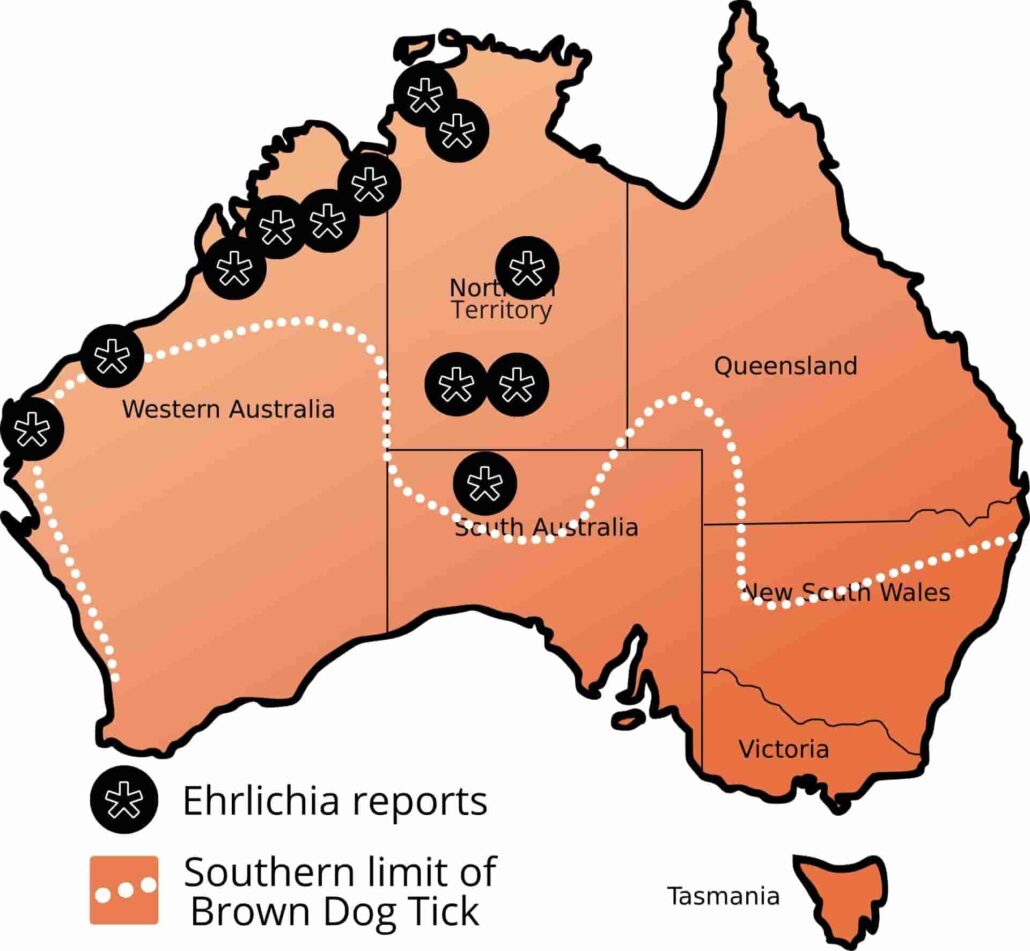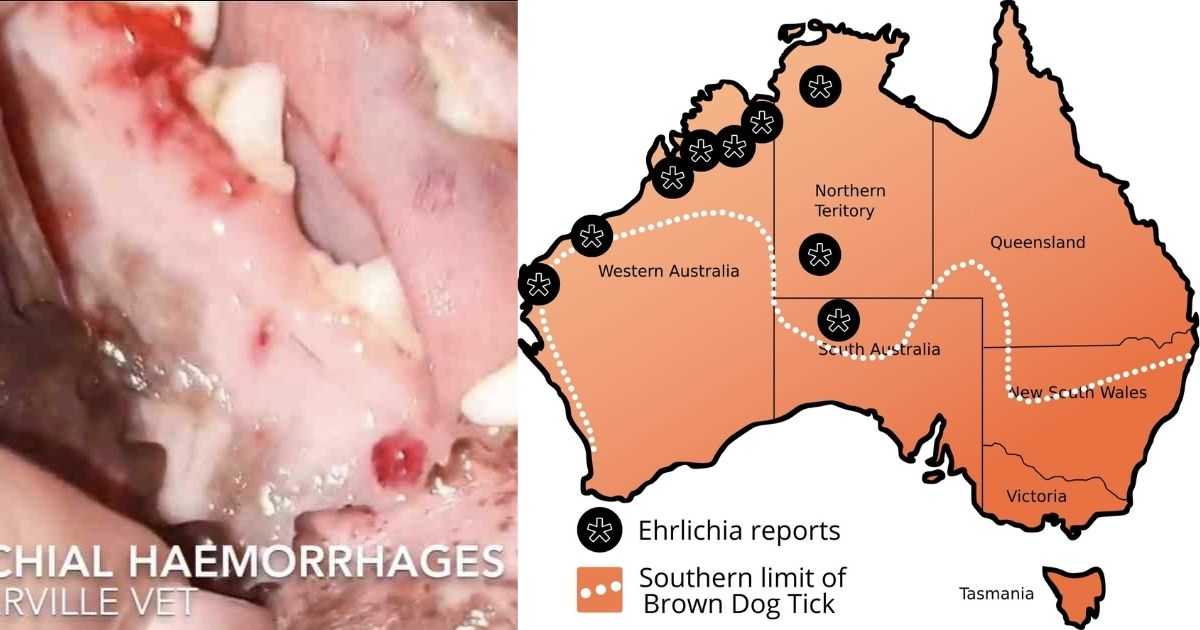Updated July 18, 2021
Canine ehrlichiosis is cause for considerable alarm for the millions of dog owners around the country.
ABC News 27/1/2021
The arrival of Ehrlichia in Australia has been devastating for some remote dog communities. However, there is no reason to panic, and prevention is easy.
Here I’m going to help Australian dog owners to understand the risks, and know how to easily prevent it.
What Is Ehrlichiosis?
Ehrlichiosis is the disease caused by a tiny bacterial blood parasite called Ehrlichia canis. It’s spread by the bite of a tick, and specifically Rhipicephalus sanguineus the Brown Dog Tick.
It causes some or all of the following signs:
- Fever and lethargy
- Swollen glands
- Discharge from the eyes and nose
- Fluid swelling of the legs and genitals
- Bleeding excessively (seen as red patches on the skin & gums, blood noses or cloudy eyes)
Death is possible in severe cases.
The Spread Of Ehrlichia In Australia
Until recently, Australia was thought to be the only continent whose dogs were free of the disease. Then, in 2020, it was found in sick dogs in the Kimberley, and then more widely across Western Australia, the Northern Territory plus a single case in far north SA. Currently there have been in excess of 300 cases and dog numbers in some remote communities are reported to have dropped by one third.

The map shows the approximate locations of positive reports. It also shows where the tick that carries it is found. As you can see, there’s a lot of Australia where the disease could still spread.
In response, governments have instigated control programs and are preventing the movement of dogs from known areas. Currently the chance of a dog getting ehrlichiosis is still very low. However, everyone who lives in these areas or travels to them should be aware of the risk.
Prevention Of Ehrlichiosis
The risk of your dog catching ehrlichiosis is closely related to two things:
- The chance of being bitten by a Brown Dog Tick
- The chance of that tick carrying Ehrlichia canis
Therefore, tick control measures are very important for dogs wherever ticks are found in the Northern Territory, Western Australia and far northern South Australia. There is less concern in Queensland, but most dogs east of the dividing range will still need to take paralysis tick treatments.
Movement Of Dogs
If you are travelling, avoid taking your dog into known infested areas unless absolutely necessary. Once you do, keep an eye on state government regulations before leaving the area or crossing state lines as the situation is likely to change rapidly.
For example, If you plan on moving your dog into southern WA from the shires of Broome, Derby-West Kimberley, Halls Creek and Wyndham-East Kimberley, you now must:
- Email animalbiosecurity@dpird.wa.gov.au with your details (name, address, email, phone number), your dogs’ details (name, age, sex, breed, microchip number), product and date of tick treatment and details of destination for the dog (you can also fill in and email a dog movement notification form)
- Ensure that all dogs being moved are healthy
- Apply one of the tick treatments mentioned on this page during the seven days before moving your dog
- Keep a record of the tick treatment for six months after the movement
- Contact the Emergency Animal Disease Hotline on 1800 675 888 if your dog becomes unwell following movement
Prevention Of Brown Dog Tick Attachment
In Brown Dog Tick areas, follow these precautions:
- Avoid areas where free ranging dogs are seen to congregate
- Keep grass short in dog yards and avoid walking in overgrown places
- Get a pest controller if ticks are found in your yard
- Check dogs daily for ticks; read how here
- Use good tick control products
- Contact local vets for more information; ticks also transmit Babesia and Anaplasma
Brown Dog Tick Control In Dogs
The prevention of ehrlichiosis requires a different strategy to tick paralysis. Whereas in tick paralysis, it’s OK if a tick attaches as long as it dies quickly, in ehrlichiosis, we don’t want the tick to attach at all.
Therefore, we use surface insecticides that can act before the tick begins to feed. Currently, there are four available in Australia:
- Advantix spot on
- Seresto collars
- Preventic collars
- Kiltix collars
Of these, I recommend the first two, as they have been experimentally shown to prevent the transmission of Ehrlichia canis to dogs (references below). However, we don’t stop with these alone.
The cornerstones of good tick paralysis prevention are the new tablets like Simparica, NexGard and Bravecto. Their outstanding efficacy and safety means that they should be used as a second line of defence. The fact that they work better for paralysis ticks shows that once the tick attaches, these are the products of choice.
I hope you can now see that preventing ehrlichiosis is not difficult for the average dog owner. But finally, let me say one last thing: if your dog gets it, doxycycline is a simple and cheap treatment. Just so long as it’s started straight away, recovery is all-but guaranteed.
Have something to add? Comments (if open) will appear within 24 hours.
By Andrew Spanner BVSc(Hons) MVetStud, a vet in Adelaide, Australia. Meet his team here.
References
Note: the distribution map for Rhipicephalus sanguineus was constructed from the first reference, with the addition of recent reports from northern South Australia. The Ehrlichia incidence reports were compiled from state government sources (I have not included a Northern Goldfields report due to vagueness about its location).
Chandra, S., Ma, G. C., Burleigh, A., Brown, G., Norris, J. M., Ward, M. P., … & Šlapeta, J. (2020). The brown dog tick Rhipicephalus sanguineus sensu Roberts, 1965 across Australia: Morphological and molecular identification of R. sanguineus sl tropical lineage. Ticks and tick-borne diseases, 11(1), 101305
Dantas-Torres, F., Capelli, G., Giannelli, A., Ramos, R. A. N., Lia, R. P., Cantacessi, C., … & Otranto, D. (2013). Efficacy of an imidacloprid/flumethrin collar against fleas, ticks and tick-borne pathogens in dogs. Parasites & vectors, 6(1), 1-8
Fourie, J. J., Luus, H. G., Stanneck, D., & Jongejan, F. (2013). The efficacy of Advantix® to prevent transmission of Ehrlichia canis to dogs by Rhipicephalus sanguineus ticks. Parasite, 20
Jongejan, F., Crafford, D., Erasmus, H., Fourie, J. J., & Schunack, B. (2016). Comparative efficacy of oral administrated afoxolaner (NexGard) and fluralaner (Bravecto) with topically applied permethrin/imidacloprid (Advantix®) against transmission of Ehrlichia canis by infected Rhipicephalus sanguineus ticks to dogs. Parasites & vectors, 9(1), 1-14.
Stanneck, D., & Fourie, J. J. (2013). Imidacloprid 10%/flumethrin 4.5% collars (Seresto®, Bayer) successfully prevent long-term transmission of Ehrlichia canis by infected Rhipicephalus sanguineus ticks to dogs. Parasitology Research, 112, 21-32


Andrew I wonder if could please contact me when you have some time to answer a few questions about the safety (to dog’s health) related to the use of the Seresto collar. I’m am planning to do a lap of Australia next year visiting areas where ehrlichiosis could be present. I plan on using NexGard (chewables) as a treatment and looking at a suitable tick repellant (as is widely recommended).
Regards,
Graeme B.
0422 759 828
Hi Graham. Unfortunately I don’t have any extra information other than that in the article. I do believe however that Seresto collars are sufficiently safe to use, as are all of the APVMA approved medicines used to prevent or treat ticks on dogs in Australia.